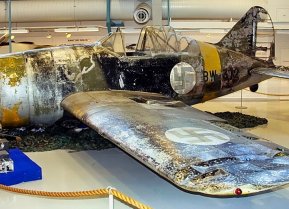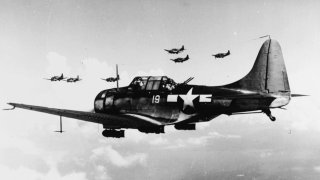Douglas SBD Dauntless: The Bomber That Sunk Imperial Japan?
Nearly 6,000 Douglas SBD Dauntless bombers were produced during World War II. The last aircraft rolled off the line in July 1944.
Underpowered, vulnerable, lacking in range, and exhausting to fly for any length of time, there was little to love about the Douglas SBD Dauntless. However, during the Battle of Midway, the SBD played a pivotal role in reversing the course of the Second World War in the Pacific.
If the aircraft had done nothing else but fight at Midway, the Douglas SBD Dauntless would still be counted as among the most important aircraft of World War II, if not the entire 20th century.
However, it did far more than just prove to be the carrier-killer in early June 1942 – and from its conception in 1938 until late 1944, the SBD proved to be the most important American dive-bomber ever built. Nicknamed "Slow But Deadly" by its pilots, the SBD was a very precise dive bomber that used special perforated dive brakes to make slower, controlled dives.
Early Victories 80 Years Ago
It was during the Battle of the Coral Sea on May 7, 1942 that the crews onboard the USS Lexington (CV-2) and USS Yorktown (CV-5) were unable to tell how the battle was going. The radio airwaves were cluttered with transmissions from pilots, but then they heard, "Scratch one flat-top! Dixon to carrier. Scratch one flat-top!"
The voice was that of Lt. Commander Robert E. Dixon, commander of Bomber Two (VB-2), who was reporting that the Japanese carrier Shoho with 545 of its crew was sunk, at the cost of only three U.S. aircraft. It was an important portent for what could come less than a month later at the Battle of Midway.
During that "turning point in the Pacific," Dauntless dive-bombers sank four of the Imperial Japanese Navy's fleet carriers: Kaga, Akagi, Hiryu and Soryu.
Few other aircraft types can lay claim to have so altered history as the Dauntless, 5,936 of which were produced by the end of the Pacific War.
Origins of the SBD Dauntless
The dive-bomber owed its origins to the low-wing, two-set Northrop BT-1 dive-bomber of 1938, and to the superb design work of Jack Northrop and of the mild-tempered and brilliant Edward H. Heinemann. The first Dauntless, a modified XBT-2, was test-flown on April 22, 1938. Just a year later, Douglas received an order for fifty-seven SDB-1 and then eighty-seven SBD-2 aircraft.
The fall of France in the late spring of 1940, punctuated by the scream of the dive-bombing Junkers Ju-87 "Stuka" impressed military planners in Washington, and highlighted the value of a dive bomber. An additional 174 SBDs were ordered as the SBD-3.
While it wasn't the most graceful looking machine, it had a maximum speed of 252 mph in level flight and could reach 276 mph in a dive. It had a range of 1,225 miles with, or 1,370 miles without, a bomb load. The aircraft was powered by the trusty Wright R-1820 Cyclone engine, and bomb armament consisted of a single weapon of up to 726 kg on the centerline or 295 kg of bombs under the wings.
The Douglas SBD Dauntless proved sturdy enough for pilots to dive at a near-vertical 80 degrees. The pilot had a telescopic bombsight projecting through the windshield. However, it tended to fog over because the change in temperature during the dive.
In the rear cockpit sat the radio operator, and it was also his job to operate the rear defensive armament, which consisted of a pair of 7.62mm (.30 caliber) Browning machine guns. In transit the weapons were stowed in the fuselage behind hinged doors. On entering the combat zone, the rear canopy was stowed in the fuselage and the guns deployed from their bay. That gave the gunner a wide field of fire.
The wings had a unique brake assembly, which extended on both the upper and lower surfaces. On the undersides, the brake surfaces were located right the way across the fuselage. All the surfaces had large holes in them, and were accordingly nicknamed "Swiss cheese" divebrakes.
Beyond Midway
SBDs went on to sink more Japanese vessels, including merchant and transport ships, than any other U.S. aircraft in the Pacific. And although it was known as a U.S. Navy warplane, the Dauntless also served in large numbers with the United States Marine Corps, which operated them from land based.
On U.S. Navy Dauntless gunner was reported to have been credited with shooting down seven Mitsubishi A6M "Zero" fighters in two days.
The aircraft's has been widely remembered for its role in the Pacific War, but Atlantic Fleet SBDs received their first taste of major action in November 1942 during the Allied landings in North Africa, known as Operation "Torch."
Nearly 6,000 Douglas SBD Dauntless dive bombers were produced during the Second World War and the final aircraft rolled off the assembly line on July 22, 1944. Today fewer than thirty survive, and only a handful of those are still airworthy.
One in the collection of the Naval Aviation Museum is the only known surviving aircraft from the Midway battle. It remains a reminder of the brave aircrews who helped turn the tide in the Second World War.
About the Author: Peter Suciu
Peter Suciu is a Michigan-based writer who has contributed to more than four dozen magazines, newspapers and websites. He regularly writes about military hardware, and is the author of several books on military headgear including A Gallery of Military Headdress, which is available on Amazon.com. Peter is also a Contributing Writer for Forbes.


